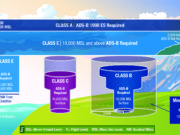The U.S. Federal Aviation Administration (FAA) says it has completed the “final implementation milestone” of its automatic dependent surveillance–broadcast (ADS-B) system, a component of the agency’s satellite-based navigation program.
The FAA said in a statement issued Monday that the last two airports to bring their ADS-B equipment online — Akron-Canton Airport and Mansfield Lahm Regional Airport, both in Ohio — began using the systems in September. The equipment is operational at a total of 155 U.S. airports.
“This brings the operational rollout of ADS-B baseline services to a successful conclusion, on schedule and within budget, well in advance of Jan. 1, 2020, the date by which aircraft flying in certain, controlled airspace must be equipped with the technology,” the FAA said.
ADS-B is operational not only at airport air traffic control facilities but also at terminal radar approach control facilities, which handle air traffic around the country’s busiest airports, and at en route facilities, which handle traffic at high altitudes.
The satellite-based ADS-B system provides more accurate information to both controllers and pilots than traditional ground-based radar systems. ADS-B also makes possible more accurate tracking of aircraft and airport vehicles on runways and taxiways; improves surveillance of air traffic in mountainous areas, over water and in other areas with “geographic challenges,” the FAA said.
Aircraft owners have until Jan. 1 to equip their aircraft with ADS-B Out technology to be permitted to fly in certain controlled airspace.
ADS-B is a key element of the FAA’s Next Generation Air Transportation System (NextGen) —a sweeping modernization of the air transportation system that is replacing aging infrastructure with new technologies, such as satellite-based navigation.

